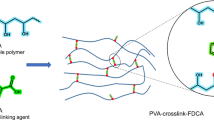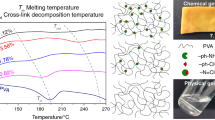Abstract
In this paper, interpenetrating polymer networks (IPNs) based on poly(vinyl alcohol) (PVA) and poly(dimethylsiloxane) with terminal vinyl groups (PDMS-vinyl) with both hydrophilic and hydrophobic features were prepared by radical reticulation. Specifically, an aqueous PVA solution was mixed with an alcoholic PDMS-vinyl solution in the presence of 2,2-dimethoxy-2-phenylacetophenone (DMPAP) and N’,N-methylenebisacrylamide (MBA) as initiating and reticulating agents, respectively, to obtain samples with the following PVA/PDMS-vinyl (w/w) compositions: 100/0, 75/25, 50/50, and 25/75. Confirmation of the IPN formation was done by a set of techniques such as Fourier transform infrared spectroscopy (FTIR), X-ray diffraction (XRD), thermogravimetric analysis (TG), differential scanning calorimetry (DSC), as well as theoretical calculations. The techniques used showed evidence of cross-linking reactions occurring in both PVA and PDMS-vinyl. Swelling experiments showed a proper balance of the resulting IPNs in swelling polar and apolar solvents, according to their composition and cross-linking. Tools of Theoretical Chemistry (Methods of Molecular Mechanics and Quantum Mechanics) were employed for the first time to investigate the cross-linking reaction between PVA and MBA and corroborate the experimental results. The PVA/PDMS IPNs showed a high capacity (up to 80 wt.%) to absorb water and may be characterised as hydrogels.







Similar content being viewed by others
References
Matricardi P, Di Meo C, Coviello T, Hennink WE, Alhaique F (2013) Interpenetrating polymer networks polysaccharide hydrogels for drug delivery and tissue engineering. Adv Drug Deliv Rev 65:1172–1187
Yoo SH, Cohen C, Hui C-Y (2006) Mechanical and swelling properties of PDMS interpenetrating polymer networks. Polymer 47:6226–6235
Sperling LH (1994) In: Klempner D, Sperling LH, Utracki LA (eds) Interpenetrating Polymer networks: an overview; advances in chemistry 239; American Chemical Society
Johnson JA, Turro NJ, Koberstein JT, Mark JE (2010) Some hydrogels having novel molecular structures. Prog Polym Sci 35:332–337
Zhou P, Frisch HL, Rogovina L, Makarova L, Zhdanov A, Sergeienko N (1993) Interpenetrating polymer networks of poly(dimethyl siloxane–urethane) and poly(methyl methacrylate). J Polym Sci A Polym Chem 31:2481–2491
Gilmer TC, Hall PK, Ehrenfeld H, Wilson K, Bivens T, Clay D, Endreszl C (1996) Synthesis, characterization, and mechanical properties of PMMA/poly(aromatic/aliphatic siloxane) semi-interpenetrating polymer networks. J Polym Sci A Polym Chem 34:1025–1037
Chang TC, Wu KH, Liao CL, Wang GP (1999) Characterization and degradation of poly(methylphenylsiloxane)–poly(methyl methacrylate) interpenetrating polymer networks. J Polym Sci A Polym Chem 37:1717–1724
Vlad S, Vlad A, Oprea S (2002) Interpenetrating polymer networks based on polyurethane and polysiloxane. Eur Polym J 38:829–835
Erbil C, Kazancıoglu E, Uyanık N (2004) Synthesis, characterization and thermoreversible behaviours of poly(dimethyl siloxane)/poly(N-isopropyl acrylamide) semi-interpenetrating networks. Eur Polym J 40:1145–1154
Dewasthale S, Shi X, Hablot E, Graiver D, Narayan R (2013) Interpenetrating polymer networks derived from silylated soybean oil and polydimethylsiloxane. J Appl Polym Sci 130:2479–2486
Diaz-Quijada GA, Wayner DDM (2004) A simple approach to micropatterning and surface modification of poly(dimethylsiloxane). Langmuir 20:9607–9611
Barbier V, Tatoulian M, Li H, Arefi-Khonsari F, Ajdari A, Tabeling P (2006) Stable modification of PDMS surface properties by plasma polymerization: application to the formation of double emulsions in microfluidic systems. Langmuir 22:5230–5232
Wang R, Yang YL, Qin M, Wang LK, Yu L, Shao B, Qiao MQ, Wang C, Feng XZ (2007) Biocompatible hydrophilic modifications of poly(dimethylsiloxane) using self-assembled hydrophobins. Chem Mater 19:3227–3231
Zhang X, Lin G, Kumar SR, Mark JE (2009) Hydrogels prepared from polysiloxane chains by end linking them with trifunctional silanes containing hydrophilic groups. Polymer 50:5414–5421
Sharpe RBA, Burdinski D, Vandermarel C, Jansen JAJ, Huskens J, Zandvliet HJW, Reinhoudt DN, Poelsema B (2006) Ink dependence of poly(dimethylsiloxane) contamination in microcontact printing. Langmuir 22:5945–5951
Kim J, Conway A, Chauhan A (2008) Extended delivery of ophthalmic drugs by silicone hydrogel contact lenses. Biomaterials 29:2259–2264
Rezaei SM, Mohd Ishak ZA (2014) Grafting of collagen onto interpenetrating polymer networks of poly(2-hydroxyethyl methacrylate) and poly(dimethyl siloxane) polymer films for biomedical applications. Exp Polym Lett 8:39–49
Uchegbu IF, Schatzlein AG (2006) Polymers in drug delivery. Bocan Rotan, London
Gao Z, Nahrup JS, Mark JE, Sakr A (2005) Poly(dimethylsiloxane) coatings for controlled drug release. III. Drug release profiles and swelling properties of the free-standing films. J Appl Polym Sci 96:494–501
Li J, Wang M, Shen Y (2012) Chemical modification on top of nanotopography to enhance surface properties of PDMS. Surf Coat Technol 206:2161–2167
Taylor JD, Linman MJ, Wilkop T, Cheng Q (2009) Regenerable tethered bilayer lipid membrane arrays for multiplexed label-free. Anal Chem 81:1146–1153
Bodas D, Khan-Malek C (2006) Formation of more stable hydrophilic surfaces of PDMS by plasma and chemical treatments. Microelectron Eng 83:1277–1279
Hemmilä S, Cauich-Rodríguez JV, Kreutzer J, Kallio P (2012) Rapid, simple, and cost-effective treatments to achieve long-term hydrophilic PDMS surfaces. Appl Surf Sci 258:9864–9875
Marques RS, Mac Leod TCO, Yoshida IVP, Mano V, Assis MD, Schiavon MA (2010) Synthesis and characterization of semi-interpenetrating networks based on poly(dimethylsiloxane) and poly(vinyl alcohol). J Appl Polym Sci 115:158–166
Carneiro LB, Ferreira J, Santos MJL, Monteiro JP, Girotto EM (2011) A new approach to immobilize poly(vinyl alcohol) on poly(dimethylsiloxane) resulting in low protein adsorption. Appl Surf Sci 257:10514–10519
Deshpande DS, Bajpai R, Bajpai AK (2012) Synthesis and characterization of polyvinyl alcohol based semi interpenetrating polymeric networks. J Polym Res 19:9938–9947
Kobayashi M, Hyu HS (2010) Development and evaluation of polyvinyl alcohol-hydrogels as an artificial articular cartilage for orthopedic implants. Materials 3:2753–2771
Kim SJ, Park SJ, Chung TD, An KH, Kim SI (2003) Properties of interpenetrating polymer network hydrogels composed of poly(vinyl alcohol) and poly(N-isopropylacrylamide). J Appl Polym Sci 89:2041–2045
Wang T, Turhan M, Guna Sekaran S (2004) Selected properties of pH-sensitive, biodegradable chitosan-poly(vinyl alcohol) hydrogel. Polym Int 53:911–918
Park KR, Nho YC (2003) Synthesis of PVA/PVP hydrogels having two layer by radiation and their physical properties. Radiat Phys Chem 67:361–365
Lopergolo LC, Lugao AB, Catalani LH (2003) Direct UV photocrosslinking of poly(N-vinyl-2-pyrrolidone) (PVP) to produce hydrogels. Polymer 44:6217–6222
Tezuka Y, Imai K (1984) Synthesis of poly(vinyl alcohol)-poly(dimethylsiloxane) block copolymer. Makromol Chem Rapid Commun 5:559–565
Tezuka Y, Fukushima A, Imai K (1985) Synthesis of poly(vinyl alcohol)/poly(dimethylsiloxane) graft copolymer. Makromol Chem 186:685–694
Tezuka Y, Fukushima A, Matsui S, Imai KJ (1986) Surface studies on poly(vinyl alcohol)-poly(dimethylsiloxane) graft gopolymers. Colloid Interface Sci 114:16–25
Pouget E, Garcia EH, Ganachaud F (2008) Direct synthesis of PVA-g-PDMS in microsuspension macromol. Rapid Commun 29:425–430
Shin MS, Kim SI, Kim IY, Kim NG, Song CG, Kim SJ (2002) Characterization of hydrogels based on chitosan and copolymer of poly(dimethylsiloxane) and poly(vinyl alcohol). J Appl Polym Sci 84:2591–2596
Shin MS, Kim SJ, Kim IY, Kim NG, Song CG, Kim SI (2002) Swollen behavior of crosslinked network hydrogels based on poly(vinyl alcohol) and polydimethylsiloxane. J Appl Polym Sci 85:957–964
Mac Leod TCO, Marques RS, Schiavon MA, Assis MD (2010) An environmentally friendly triphasic catalytic system: Mn(salen) occluded in membranes based on PDMS/PVA. Appl Catal B 100:55–61
Hypercube, Inc HyperChem, Release 7.5 for Windows, Reference Manual, Copyright© (2002)
Peppas NA, Merrill EW (1977) Development of semicrystalline poly(vinyl alcohol) hydrogels for biomedical applications. J Biomed Mater Res 11:423–434
Mijangos I, Navarro-Villoslada F, Guerreiro A, Piletska EV, Chianella I, Karim K, Turner APF, Piletsky SA (2006) Influence of initiator and different polymerisation conditions on performance of molecularly imprinted polymers. Biosens Bioelectron 22:381–387
Matyjaszewski K, Davis TP (2002) Handbook of radical polymerization. Canada
Ibrahim SM (2003) Synthetic absorbent for dye stuffs based on gamma crosslinked poly(vinyl alcohol) (PVA). J Appl Polym Sci 89:349–354
Mansur HS, Sadahira CM, Souza AN, Mansur AAP (2008) FTIR spectroscopy characterization of poly (vinyl alcohol) hydrogel with different hydrolysis degree and chemically crosslinked with glutaraldehyde. Mater Sci Eng C 28:539–548
Bellamy LJ (1958) The infra-red spectra of complex molecules. New York
Shao C, Kim HY, Gong J, Ding B, Lee DR, Park SJ (2003) Fiber mats of poly(vinyl alcohol)/silica composite via electrospinning. Mater Lett 57:1579–1584
Holland BJ, Hay JN (2001) The thermal degradation of poly(vinyl alcohol). Polymer 42:6775–6783
Schiavon MA, Redondo SUA, Pina SRO, Yoshida IVP (2002) Investigation on kinetics of thermal decomposition in polysiloxane networks used as precursors of silicon oxycarbide glasses. J Non-Cryst Solids 304:92–100
Krumova M, López D, Benavente R, Mijangos C, Pereña JM (2000) Effect of crosslinking on the mechanical and thermal properties of poly(vinyl alcohol). Polymer 41:9265–9272
Aranguren MI (1998) Crystallization of polydimethylsiloxane: effect of silica filler and curing. Polymer 39:4897–4903
Acknowledgments
This work was supported by Coordenação de Aperfeiçoamento de Pessoal de Nível Superior–CAPES, Conselho Nacional de Desenvolvimento Científico e Tecnológico–CNPq and Fundação de Amparo à Pesquisa de Minas Gerais–FAPEMIG.
Author information
Authors and Affiliations
Corresponding author
Rights and permissions
About this article
Cite this article
Coelho, E.C., dos Santos, D.P., Ciuffi, K.J. et al. Poly(vinyl alcohol) and poly(dimethylsiloxane)-based interpenetrating polymer networks via radical polymerisation. J Polym Res 21, 561 (2014). https://doi.org/10.1007/s10965-014-0561-x
Received:
Accepted:
Published:
DOI: https://doi.org/10.1007/s10965-014-0561-x




